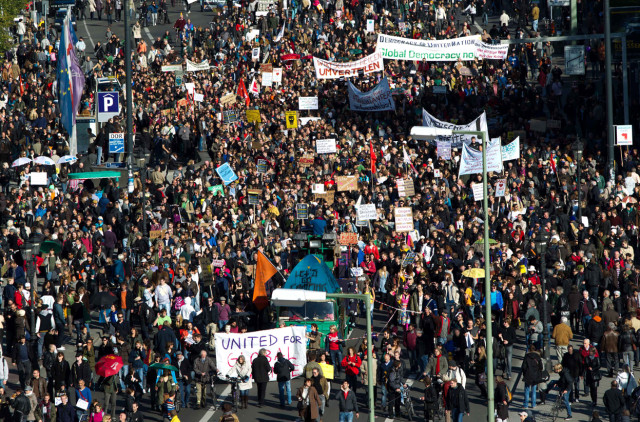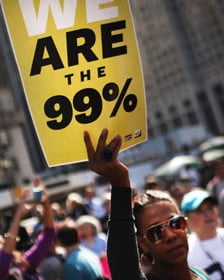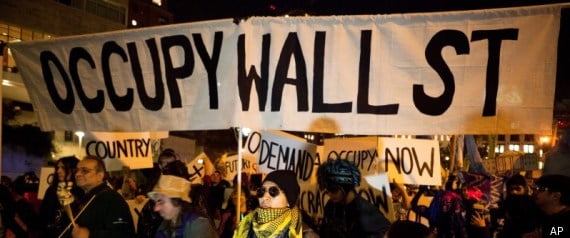By Saloni Singhal
 Movements and uprisings are most likely to occur when a prolonged period of objective economic and social development is followed by a short period of sharp reversal. People then subjectively fear that ground gained with great effort will be quite lost; their mindset and actions become rebellious and an uprising is born.
Movements and uprisings are most likely to occur when a prolonged period of objective economic and social development is followed by a short period of sharp reversal. People then subjectively fear that ground gained with great effort will be quite lost; their mindset and actions become rebellious and an uprising is born.
It all started with the great recession of United States of America in December 2007. This gust of wind which came when the 8.9 trillion housing bubble broke took no time to turn into a violent tornado which left 8.7 million people jobless. According to the department of labor, the GDP fell far below what the economy was capable of producing. It contracted by 5.1% in a span of 18 months and unemployment reached its peak -10 % in October 2008. But the recession did more damage to the economy than what was seen on the surface. It created a huge gap between the rich and the middle class.
The reason for this can be ascribed to the derailing of the train of a common trend:Land an entry-level job. Accept a modest wage. Gain skills. Leave eventually for a better-paying job. This happened because when people lost their jobs during recession, they were bound to take whatever opportunity was available in the market. Thus, they had no choice but to accept the low- wage employment opportunities left.
According to a recent study by University of California Berkeley economists Emmanuel Saez and Thomas Piketty ; From 2009 to 2012, the top 1% incomes grew by 31.4% while the bottom 99% incomes grew a mere 0.4%. This appalling fact dawned upon millions of people worldwide when an article authored by Joseph Stiglitz was published in “Vanity Fair”.
“In our democracy, 1% of the people take nearly a quarter of the nation’s income … In terms of wealth rather than income, the top 1% control 40% … thus the top 1% have the best houses, the best educations, the best doctors, and the best lifestyles, but there is one thing that money doesn’t seem to have bought: an understanding that their fate is bound up with how the other 99% live. Throughout history, this is something that the top 1% eventually do learn. Too late.”
—Joseph Stiglitz, “Of the 1%, by the 1%, for the 1%”, Vanity Fair, May 2011
 It was then that people started to raise their voice against the injustice that was done to them and came together as a team in what is called the “occupy wall street movement”. This public powered movement with its famously apt slogan “we are the 99%” began on 17th September, 2011 in liberty square in Manhattan’s Financial District, and spread to over 100 cities in the United States and its actions covered 1,500 cities worldwide. Its aim was to fight back against the richest 1% of people that were writing the rules of an unfair global economy that was foreclosing on their future.
It was then that people started to raise their voice against the injustice that was done to them and came together as a team in what is called the “occupy wall street movement”. This public powered movement with its famously apt slogan “we are the 99%” began on 17th September, 2011 in liberty square in Manhattan’s Financial District, and spread to over 100 cities in the United States and its actions covered 1,500 cities worldwide. Its aim was to fight back against the richest 1% of people that were writing the rules of an unfair global economy that was foreclosing on their future.
 The movement also drew motivation from the popular uprisings of Tunisia and Egypt which led to the peaceful unseating of the authoritarian rulers: Zine Al Abidine Bin Ali in Tunisia and Hosni Mubarak in Egypt.
The movement also drew motivation from the popular uprisings of Tunisia and Egypt which led to the peaceful unseating of the authoritarian rulers: Zine Al Abidine Bin Ali in Tunisia and Hosni Mubarak in Egypt.
It has been almost 3 years since the movement began to take shape. Its time now to reflect and ponder upon what has been achieved in this time.
Even though the income inequality has been growing with the recent statistics showing that last year, the top 1 percent of Americans took home 19 percent of the country’s household income, their biggest share since the 20’s , the occupy movement , to some extent has changed the way people think about running their economy.
Charles M. Blow, writing in the New York Times, agrees:
“The Occupy Wall Street movement, which many dismissed as the wails of the young and disaffected without clear objectives, clear leaders, or a clear political agenda, may, in the end, have a rather clear legacy: Ingraining in the national conscience the idea that our extreme levels of inequality are politically untenable and morally unacceptable, and that eventually the 99 percent will demand better.”
Occupy movement has made people from all sections of the society, think about upward mobility and economic inequality. Its message was also understated everywhere in Obama administration’s re-election campaign. Even though it did not have very prominent impacts, it was widely appreciated by the common masses. According to a survey, 43% Americans favored the movement.
This fight for justice faced mixed reactions from people all over the world.
Manmohan Singh, the then prime minister of India described the protests as “a warning for all those who are in charge of the processes of governance”. Iran’s Supreme Leader Ayatollah Khamenei also supported the Occupy Movement saying, “Ultimately, it will grow so that it will bring down the capitalist system and the West.” Even business magnate Richard Branson voiced his opinion saying the movement was a good start and the people have been protesting for valid reasons.
But there still were some conservatives and pundits, who had a different opinion about the whole affair. They criticized the demonstrators by sating them as nothing more than a “growing mob of shiftless protestors engaged in class warfare whose grievances – whatever they are – are far outside the political mainstream.” Such vitriolic and derogatory remarks often cropped up here and there on news channels, newspapers and magazines but anything these people said went unheard by the protestors.
The Occupy Wall Street movement inspired hundreds of smaller protests all over the word despite its many shortcomings.
In India, within two months, in November a plot of government-owned land was occupied in Jobat, Madhya Pradesh, India. The occupiers were mostly hilly adivasis (indigenous people) ousted from their land by the Sardar Sarovar dam and linked to the Narmada Bachao Andolan (NBA) – an anti-dam movement.
The adivasis were joined by other villagers affected by the Jobat dam. They called for compensation for the more than 150 citizens displaced since 1994 by the construction of thirty large dams along the Narmada valley in central India. Despite various promises and ‘action plans’ completed by regional and national authorities, some of the claimants have never been legally compensated for their loss. Just like Madhya Pradesh, some other states also faced similar protests.
But, these small protests could never take the shape of an organized movement like the one that was happening at time in United States of America. This was because of various reasons: people did not have a fixed agenda, they were not organized, had no proper leader to guide them and most importantly the fact that ours is not a capitalist country made all the difference at that time. India has a mixed economy that means it has elements of both a socialist as well as a capitalist economy. In our country, there is no such concentration of wealth among the people in the finance sector. Even though we have a smaller version of Wall Street in Mumbai – Dalal Street, no such movement can ever be expected against it.
If there ever happens something like the occupy movement, it will be against the politicians and the ultra rich industrialists who control these politicians as well as their decision making and will require an altogether new generation of protestors. Still, there is quite a lot that is to be learned from these movements as they continue to motivate and inspire millions of people worldwide to stand up against any form of injustice that happens against them.

































